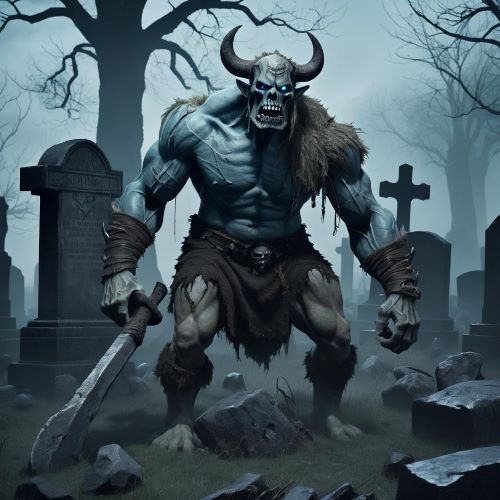Northern European Ghosts
Northern European Ghosts are powerful figures in the folklore of Finnish, Sámi, Icelandic, Estonian, and Norse traditions, reflecting humanity’s enduring fascination with death and the afterlife. These spirits often lingered between worlds, carrying messages, warnings, or curses. They could appear as ancestral guides, restless wanderers, or dangerous beings bound by unfinished business. Ghosts in Northern European mythology reveal the deep cultural importance of honoring the dead and understanding the fragile boundary between life and the spirit realm.
In Norse mythology, one of the most striking examples is the draugr, an undead being that haunted graves and burial mounds. Draugar were not merely passive ghosts but physically powerful entities capable of tormenting the living, guarding treasures, and spreading terror. They reflected Norse fears of improper burials and the need to respect the dead. Icelandic sagas expand on these themes, telling chilling tales of revenants who returned to disrupt villages until rituals or heroic deeds laid them to rest.
Finnish folklore also abounds with ghostly figures, often tied to the veneration of ancestors. Spirits of the dead were believed to watch over their descendants, bringing blessings when honored but misfortune when neglected. Forest spirits and restless souls could also appear to hunters and travelers, testing their respect for sacred laws. These encounters emphasized the importance of ritual and the deep bond between the living and the dead in Finnish culture.
In Sámi tradition, ghosts and ancestral spirits held a sacred role in shamanic practices. Shamans often communicated with the spirits of the dead to seek guidance, protection, or healing. Yet not all ghosts were benevolent; some were restless and had to be appeased through offerings and rituals. This belief system reinforced the Sámi understanding that life and death were interconnected cycles, with spirits remaining part of the community.
Estonian myths also feature ghostly beings tied to the land and local folklore. Spirits of ancestors, unquiet dead, or wandering souls often appeared to deliver warnings or demand justice. Some tales describe spectral guardians who protected sacred sites, while others speak of vengeful spirits that haunted wrongdoers. Collectively, Northern European Ghosts embody the cultural understanding that death is not an ending but a transformation, and that the presence of the dead continues to shape the world of the living.
Northern European Ghosts are powerful figures in the folklore of Finnish, Sámi, Icelandic, Estonian, and Norse traditions, reflecting humanity’s enduring fascination with death and the afterlife. These spirits often lingered between worlds, carrying messages, warnings, or curses. They could appear as ancestral guides, restless wanderers, or dangerous beings bound by unfinished business. Ghosts in Northern European mythology reveal the deep cultural importance of honoring the dead and understanding the fragile boundary between life and the spirit realm.
In Norse mythology, one of the most striking examples is the draugr, an undead being that haunted graves and burial mounds. Draugar were not merely passive ghosts but physically powerful entities capable of tormenting the living, guarding treasures, and spreading terror. They reflected Norse fears of improper burials and the need to respect the dead. Icelandic sagas expand on these themes, telling chilling tales of revenants who returned to disrupt villages until rituals or heroic deeds laid them to rest.
Finnish folklore also abounds with ghostly figures, often tied to the veneration of ancestors. Spirits of the dead were believed to watch over their descendants, bringing blessings when honored but misfortune when neglected. Forest spirits and restless souls could also appear to hunters and travelers, testing their respect for sacred laws. These encounters emphasized the importance of ritual and the deep bond between the living and the dead in Finnish culture.
In Sámi tradition, ghosts and ancestral spirits held a sacred role in shamanic practices. Shamans often communicated with the spirits of the dead to seek guidance, protection, or healing. Yet not all ghosts were benevolent; some were restless and had to be appeased through offerings and rituals. This belief system reinforced the Sámi understanding that life and death were interconnected cycles, with spirits remaining part of the community.
Estonian myths also feature ghostly beings tied to the land and local folklore. Spirits of ancestors, unquiet dead, or wandering souls often appeared to deliver warnings or demand justice. Some tales describe spectral guardians who protected sacred sites, while others speak of vengeful spirits that haunted wrongdoers. Collectively, Northern European Ghosts embody the cultural understanding that death is not an ending but a transformation, and that the presence of the dead continues to shape the world of the living.


